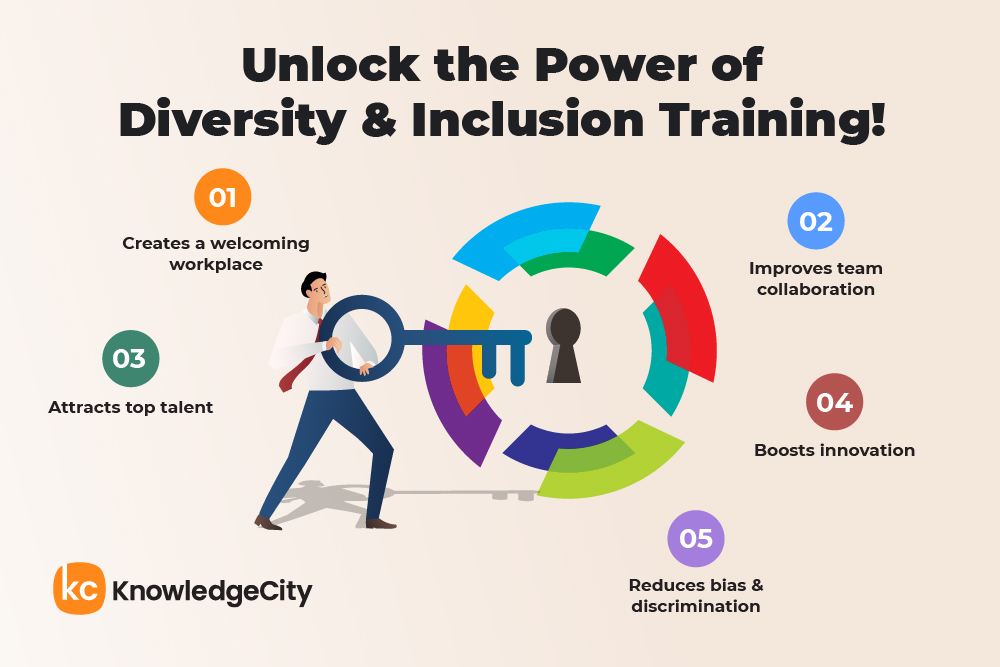Diversity and inclusion have become buzzwords in the modern workplace, but what do they really mean, and why are they important?
Diversity refers to the differences among individuals, including but not limited to: race, ethnicity, gender, sexual orientation, age, and religion. Inclusion, on the other hand, is the practice of creating a work environment where all individuals feel valued, respected, and supported.

In recent years, there has been a growing recognition of the importance of diversity and inclusion in the workplace. Companies are realizing that a diverse and inclusive workforce not only leads to a more positive work environment, but also has a direct impact on the bottom line.
In this article, we will explore the importance of diversity and inclusion training in building a more accepting workplace and provide resources for companies to implement their own training programs.
Why Is Diversity and Inclusion Training Important?
Diversity and inclusion (D&I) training plays a vital role in cultivating a positive and successful work environment. One key benefit is the creation of a more welcoming workplace. By raising awareness about unconscious bias and stereotypes, D&I training helps employees recognize and challenge these assumptions. This leads to healthy interactions and builds an environment where everyone feels valued for their unique contributions.
D&I training also fuels innovation and creativity as diverse teams bring together different perspectives and experiences. This training helps employees understand and leverage these differences to tackle problems collaboratively. The result is a more innovative and effective approach to decision-making.
D&I training also enhances employee engagement. When employees feel like they belong and their voices are heard, they are naturally more invested in their work. This training creates a sense of belonging, leading to a more satisfied and committed workforce.
The impact of D&I training extends beyond the internal environment. Companies with a strong reputation for diversity and inclusion are seen as more attractive to customers who want to support businesses with strong ethics. According to Forrester, 55% of US consumers would rather buy from a brand that reflects the customer’s personality.
Here are some other reasons diversity and inclusion training is necessary:
- Promotes Understanding and Empathy: Diversity and inclusion training helps employees understand and appreciate the differences among their colleagues. It promotes empathy and encourages individuals to see things from different perspectives.Through training, employees can learn about different cultures, backgrounds, and experiences, which can lead to a more understanding workplace.
- Reduces Bias and Discrimination: Unconscious bias and discrimination can have a significant impact to job performance and satisfaction. D&I training can help employees recognize and address their own biases, leading to a more fair and equitable workplace.By educating employees on the importance of diversity and inclusion, companies can create a culture where everyone is embraced and treated fairly.
- Improves Team Dynamics and Collaboration: A diverse and inclusive workplace can lead to improved team dynamics and collaboration. When employees feel valued and included, they’re more likely to contribute their unique perspectives and ideas, leading to better problem-solving and decision-making.Diversity and inclusion training can also help employees understand how to work effectively with individuals from different backgrounds, leading to more successful and productive teams.
- Attracts and Retains Top Talent: In a competitive job market, diversity and inclusion are important factors for job seekers. Companies that prioritize diversity and inclusion are more likely to attract top talent and retain their employees.According to Pew Research, 61% of respondents say their company or organization has policies that ensure fairness in hiring, pay or promotions; and 52% say they have training or meetings on D&I at work.
Diversity and inclusion training can demonstrate a company’s commitment to creating an inclusive workplace, making it an attractive place to work for individuals from diverse backgrounds.
How Can Companies Implement Diversity and Inclusion Training?
There are several ways companies can implement diversity and inclusion training in their workplace. They include:
- Using Free Training Materials: There are many free resources available online for companies to use in their diversity and inclusion training. These resources include videos, articles, and interactive activities that can be used to educate employees on the importance of diversity and inclusion. KnowledgeCity offers many white papers and eBooks designed to aid businesses in any challenge they may be facing.
- Hiring a Diversity and Inclusion Consultant: Companies can also hire a diversity and inclusion consultant to develop and administer training programs. These consultants have expertise in creating inclusive workplaces, and can tailor training programs to meet the specific needs of a company.Diversity and Inclusion consultants help companies create fairer workplaces by assessing their current practices, building strategic plans, and providing training on topics like unconscious bias. They also work with the organization to develop inclusive policies and navigate cultural shifts that come with a more diverse workforce.
- Provide Ongoing Training and Education: Diversity and inclusion training should not be a one-time event. Companies should provide ongoing training and education to ensure that employees are continuously learning and growing in their understanding of diversity and inclusion.This can include workshops, seminars, and webinars on various topics related to diversity and inclusion, as well as providing resources for employees to continue their education on their own.
Who Is Responsible for Diversity and Inclusion Training?
Companies typically designate a diversity and inclusion team or a dedicated manager to oversee training programs and initiatives. This team is responsible for developing and implementing D&I training, as well as creating policies and programs to promote diversity and inclusion in the workplace.
They stay current on best D&I practices and conduct assessments to identify areas where the company can improve its efforts. They also measure the effectiveness of training initiatives to make sure they achieve the desired outcome.
Senior leadership sets the overall direction for the company culture. Leaders demonstrate this commitment by actively participating in the training themselves and showing their willingness to learn alongside their employees. They also champion D&I initiatives throughout the organization, making it clear that diversity and inclusion are core values.
The Human Resources (HR) department often takes the lead in developing and implementing D&I training programs. They may work with external consultants or develop in-house programs tailored to the company’s specific needs. HR also plays an important role in leading the training sessions, ensuring accessibility for all employees no matter their background or position.
D&I training equips employees with the knowledge and skills they need to recognize and challenge their own biases, promote positive interactions with colleagues, and create a sense of belonging for everyone they work with. The success of D&I efforts relies on an ongoing commitment from every member of the organization, emphasizing a culture of respect that benefits everyone.
Building an Inclusive Workplace with KnowledgeCity
Diversity and inclusion training promotes understanding, reduces bias and discrimination, improves team dynamics, and attracts top talent. Companies can implement diversity and inclusion training by utilizing free training materials, hiring a consultant, and providing ongoing training and education.
By prioritizing diversity and inclusion training, companies can create a more equitable workplace for all employees.
Subscribe to Our Newsletter
Join 80,000+ Fellow HR Professionals. Get expert recruiting and training tips straight
to your inbox, and become a better HR manager.

 KnowledgeCity
KnowledgeCity 











